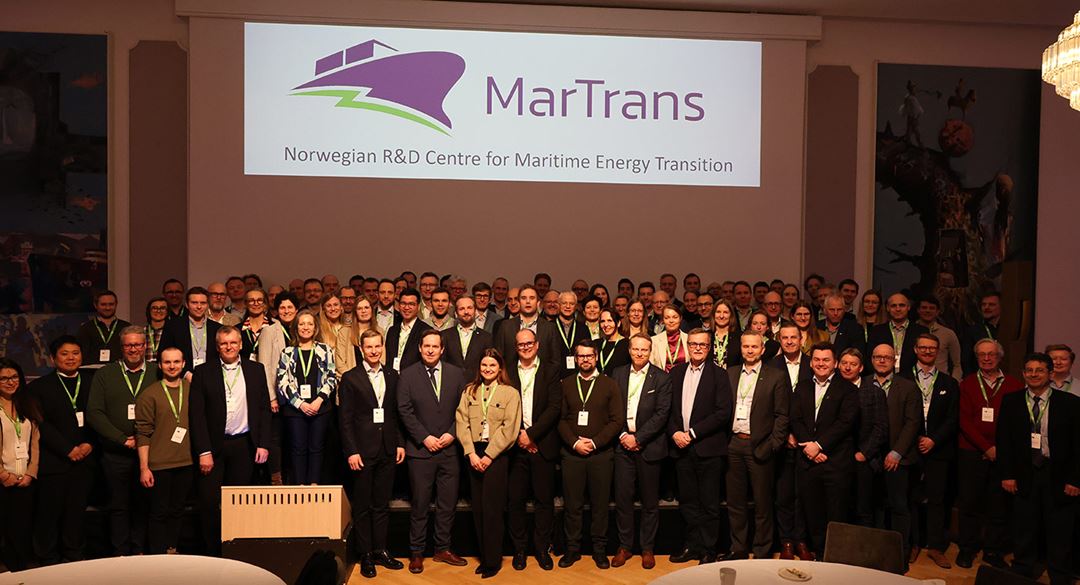Sustainable shipping and increased value creation in Norwegian industry are the goals for one of the world's largest maritime research centres. 60 of the project's partners met in Trondheim during the official launch.
- This is a dream come true. Bringing together the maritime cluster in the work towards our common goal is significant, said SINTEF CEO and president, Alexandra Bech Gjørv.
She was very pleased when she opened the centre together with the CEO of NHO, Ole Erik Almlid, on Wednesday, February 6.
- In this centre, we see the combination of an industry in need of transformation, knowledge that contributes to green transformation, and at the same time increases the competitiveness of the Norwegian maritime industry, said Almlid.
The Norwegian maritime industry has a turnover of over 600 billion NOK and around 300 billion NOK in export revenues annually, making it Norway's second-largest export industry after oil and gas.
At the FME MarTrans research centre, partners from the maritime industry, Universities and research institutions will work together over the next eight years to bring the industry closer to the goal of zero emissions by 2050. However, the sector faces significant challenges.
Four main challenges to solve
Maritime transport is efficient but still accounts for nine percent of Norway's greenhouse gas emissions and 12 percent of global transport emissions. To eliminate emissions from ships, we must solve four main challenges, stated Center Director Trond Johnsen in his opening speech.
- Energy consumption must be drastically reduced, green and safe energy systems on board must be developed, a reliable and cost-effective supply of green fuels must be ensured, and we must ensure that everything happens in an economically and environmentally sustainable way," said Johnsen.
The research activities at the centre will focus on these topics. In addition, the centre will stimulate innovation and the adoption of new solutions through industry-driven demo projects.The centre will educate the experts needed for the maritime sector to transition into a green future.
- The centre will educate around 100 students at master's and PhD levels. Students will be partnered with industry partners early on to ensure the most relevant specialization possible, said Professor Stein Ove Erikstad from NTNU, who coordinates the academic part of the centre.
During the opening event, several partners talked about how they are preparing for a greener maritime industry. Batteries, ammonia, hydrogen, biofuels, sails, air lubrication, and AI navigation were some of the topics discussed on stage. And although not everyone is going for the same solution, everyone is focused on strengthening competitiveness.
Competitiveness
On September 9 last year, former European Central Bank President, Mario Draghi, presented a high-level report on European competitiveness, with a particular focus on how Europe can strengthen its global position in the face of increasing competition and geopolitical challenges.
Almlid from NHO sees FME MarTrans as an important tool to further accelerate the decarbonization of the maritime sector and combine this with increased competitiveness.
- To become carbon neutral by 2050, we need more industry-oriented innovation and research. This is a great day, and I congratulate you all, said NHO leader Almlid before he and SINTEF's CEO cut the red ribbon and declared the centre open.
FME Maritime Energy Transition (MarTrans) is funded by the Norwegian Research Council and the industrial partners and has a budget of over 300 million NOK.

Partners
Research institutions: SINTEF Ocean, SINTEF Energi, SINTEF Industri, SINTEF Nordvest, NTNU, NHH, UiT, Chalmers (SE), DTU (DK), VTT (FI), IIASA (AUT), NTUA (GRE).
Industry and public partners: Amon Maritime, AQS, Bergen Engines, Brunvoll, Corvus, DNV, Eitzen Rederi, Elinett, Fjord Base, Fjuel, Frøy, Gard, GC Rieber Shipping, Global Centre for Maritime Decarbonisation, Glocal green, GreenH, Grieg Star, HAV Group, Havila Shipping, Hydrogenious LOHC Maritime, HD Hyundai Europe R&D Centre, HYDS, Höegh Autoliners, Island Offshore, Jotun, K.G. Jebsen Skipsrederi, Klaveness, Kongsberg, Kristiansand Havn, Miljødirektoratet, Moen Marin, Manta Marine Technologies, Molgas Energy, Narvik Havn, Navtor, North Sea Container Line, Norske Havner, Oslo Havn, Plug, Rederiforbundet, SFL Corp, Sirius Design & Integration, Sjøfartsdirektoratet, Skarv Shipping Solutions, Skuld, Solvang, Trondheim Havn, Trøndelag fylkeskommune, Ulmatec Pyro, Ulstein, Utkilen, Vard Group.



